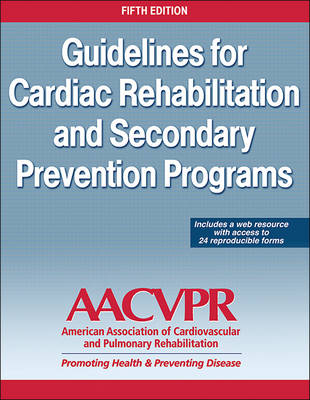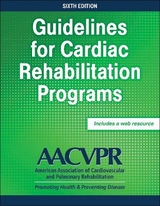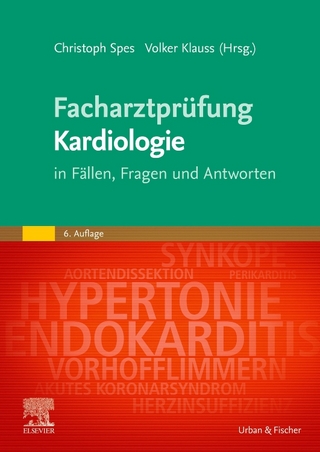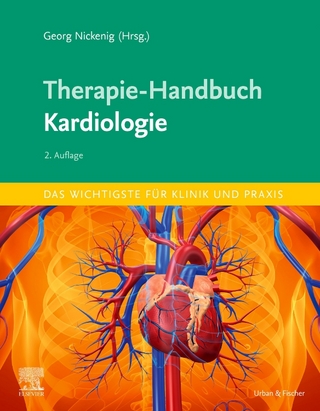
Guidelines for Cardiac Rehabilitation and Secondary Prevention Programs
Human Kinetics (Verlag)
978-1-4504-5963-1 (ISBN)
- Titel erscheint in neuer Auflage
- Artikel merken
Guidelines for Cardiac Rehabilitation and Secondary Prevention Programs, Fifth Edition With Web Resource, covers the entire scope of practice for cardiac rehabilitation and secondary prevention (CR/SP) programs. This text was developed by the American Association of Cardiovascular and Pulmonary Rehabilitation (AACVPR) and parallels federal guidelines for cardiac rehabilitation programs. It contains information on promoting positive lifestyle behavior patterns, reducing risk factors for disease progression, and lessening the impact of cardiovascular disease on quality of life, morbidity, and mortality.
The text has been updated and restructured, providing the most current models for designing and updating rehabilitation programs for patients and preventing second episodes. In addition to chapter revisions, there is new content on behavior modification, risk factors, and special populations. The chapter covering program administration has been completely rewritten to include new regulations and reimbursement standards as well as additional suggestions for new models for CR/SP. The most recent Core Competencies for Cardiac Rehabilitation and Secondary Prevention Professionals and the Core Components of Cardiac Rehabilitation/Secondary Prevention Programs have also been included in their entirety.
More than 50 leaders in the field of CR/SP, cardiovascular risk reduction, reimbursement, and public policy have contributed the latest tools and information, enabling cardiac rehabilitation professionals to successfully start new programs or update and enhance existing ones. Key features of the fifth edition include the following:
• A new web resource incorporates 24 questionnaires, charts, consent forms, protocols, records, checklists, and logs from the text that can be used when creating or assessing programs.
• Highlighted guidelines in each chapter cover current issues and provide hints and methods for implementing treatment programs and helping patients stay on track.
• Chapter objectives and summaries help readers quickly assess the topics covered and identify the most important points.
There is strong evidence that participation in outpatient cardiac rehabilitation and secondary prevention programs decreases mortality and recurrent morbidity after a cardiac event. Guidelines for Cardiac Rehabilitation and Secondary Prevention Programs, Fifth Edition, offers procedures for providing patients with low-cost, high-quality programming, moving them toward personal responsibility for disease management and secondary prevention over a lifetime. This is the definitive resource for developing inpatient and outpatient cardiac rehabilitation programs.
The American Association of Cardiovascular and Pulmonary Rehabilitation (AACVPR) is the worldwide leader in promoting the value and practice of cardiovascular and pulmonary rehabilitation. AACVPR's mission is improving the quality of life for patients and their families by reducing morbidity, mortality, and disability from cardiovascular and pulmonary diseases through education, prevention, rehabilitation, research, and aggressive disease management.
Chapter 1. Cardiac Rehabilitation, Secondary Prevention Programs, and the Evolution of Health Care
Providing Optimal Care for All Patients
Cardiac Rehabilitation: Finding Its Place in the Evolving Health Care Arena
Cardiac Rehabilitation Programs as Secondary Prevention Centers
Summary
Chapter 2. The Continuum of Care: From Inpatient and Outpatient Cardiac Rehabilitation to Long-Term Secondary Prevention
Cardiovascular Continuum of Care
Efforts to Reduce Gaps in the Continuum of Care
The Role of CR in the Continuum of Care
Putting It All Together
Summary
Chapter 3. Behavior Modification and Risk Factor Reduction: Guiding Principles and Practices
Overview of Patient Education and Health Behavior Change
Summary
Chapter 4. Nutrition Guidelines
Dietary Patterns
Obesity and Weight Control
Fat Versus Sugar Intake
Anti-Inflammatory Diet
Dietary Supplements
Relevant Guideline Updates
Summary
Chapter 5. Cardiac Rehabilitation in the Inpatient and Transitional Settings
Assessment, Mobilization, and Risk-Factor Management
Discharge Planning
Clinical Pathways
Staffing
Space and Equipment
Transitional Programming
Summary
Chapter 6. Medical Evaluation and Exercise Testing
Physical Examination
Risk Stratification and Identification of Contraindications for Exercise Training
Summary
Chapter 7. Outpatient Cardiovascular Rehabilitation and Secondary Prevention
Structure of Secondary Prevention
Coaching and Case Management
Assessment and Management of Risk Factors for Disease Progression
Innovation in CR/SP
Maintenance CR/SP
Implementation of Secondary Prevention
Summary
Chapter 8. Modifiable Cardiovascular Disease Risk Factors
Tobacco Use
Abnormal Lipids
Hypertension
Physical Inactivity
Diabetes
Psychosocial Considerations
Overweight and Obesity
Emerging Risk Factors
Summary
Chapter 9. Special Populations
Older and Younger Adults
Women
Racial and Cultural Diversity
Revascularization and Valve Surgery
Dysrhythmias
Heart Failure and Left Ventricular Assist Devices
Cardiac Transplantation
Peripheral Arterial Disease
Chronic Lung Disease
Summary
Chapter 10. Program Administration
Program Priorities
Facilities and Equipment
Organizational Policies and Procedures
Insurance and Reimbursement
Documentation
Personnel
Continuum of Care and Services
Summary
Chapter 11. Outcomes
Outcome Matrix
Outcomes In Contrast To Performance Measures
Resources
Summary
Chapter 12. Management of Medical Problems and Emergencies
Potential Risks in Outpatient CR/SP
Intervention Summary
Nontraditional Programs
Summary
| Zusatzinfo | 8.5 |
|---|---|
| Verlagsort | Champaign, IL |
| Sprache | englisch |
| Maße | 216 x 279 mm |
| Gewicht | 907 g |
| Themenwelt | Medizinische Fachgebiete ► Innere Medizin ► Kardiologie / Angiologie |
| Medizin / Pharmazie ► Physiotherapie / Ergotherapie ► Rehabilitation | |
| Studium ► 1. Studienabschnitt (Vorklinik) ► Physiologie | |
| Studium ► Querschnittsbereiche ► Prävention / Gesundheitsförderung | |
| ISBN-10 | 1-4504-5963-3 / 1450459633 |
| ISBN-13 | 978-1-4504-5963-1 / 9781450459631 |
| Zustand | Neuware |
| Informationen gemäß Produktsicherheitsverordnung (GPSR) | |
| Haben Sie eine Frage zum Produkt? |
aus dem Bereich



